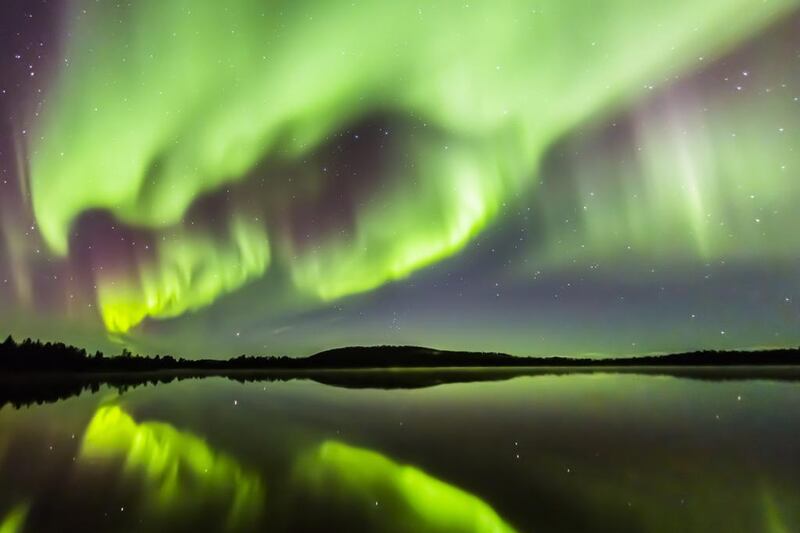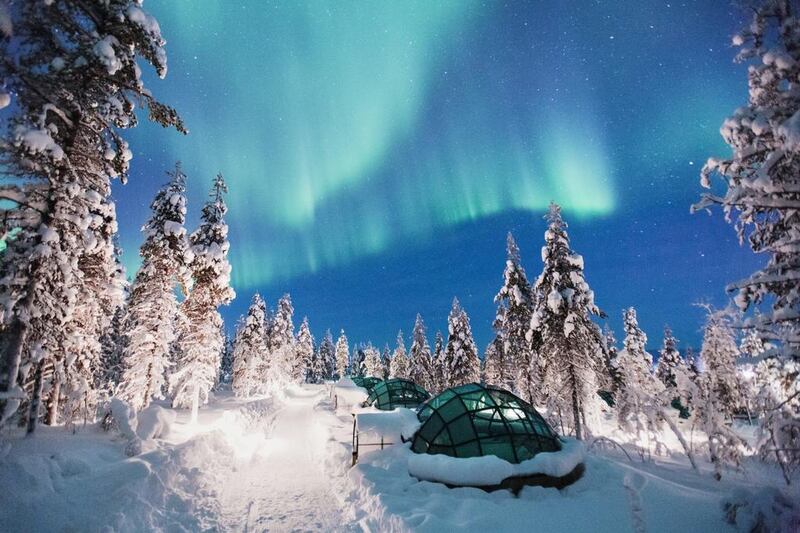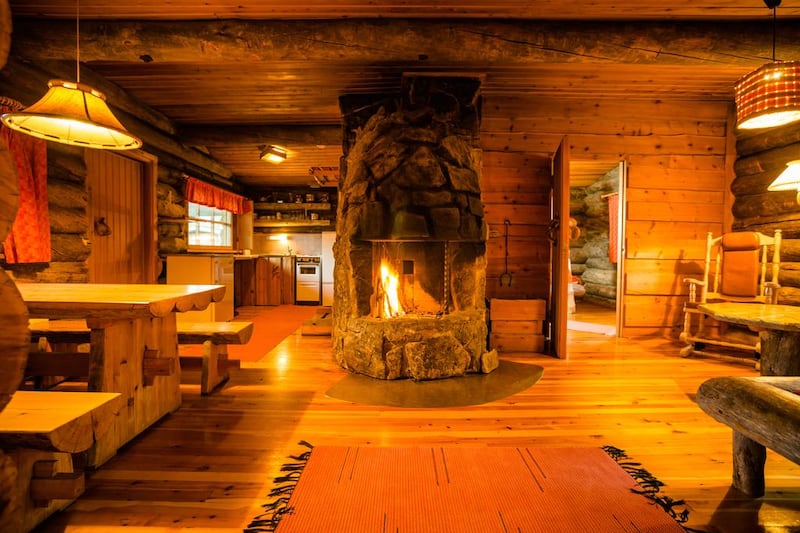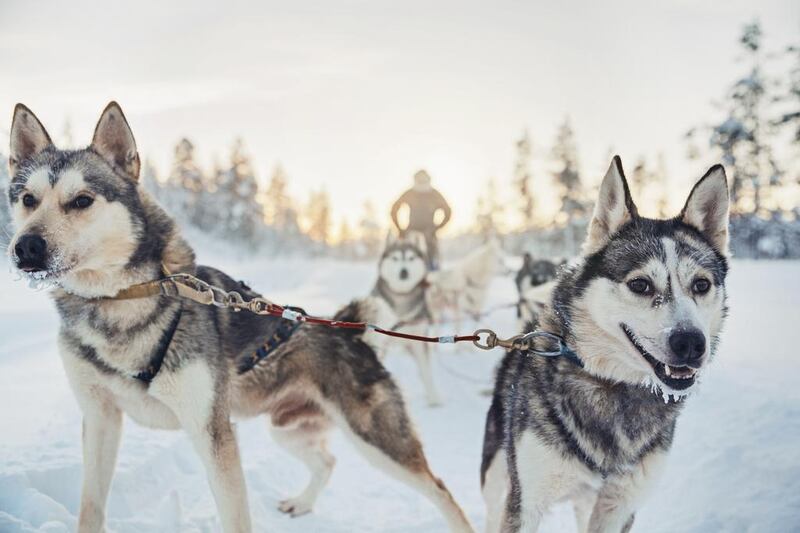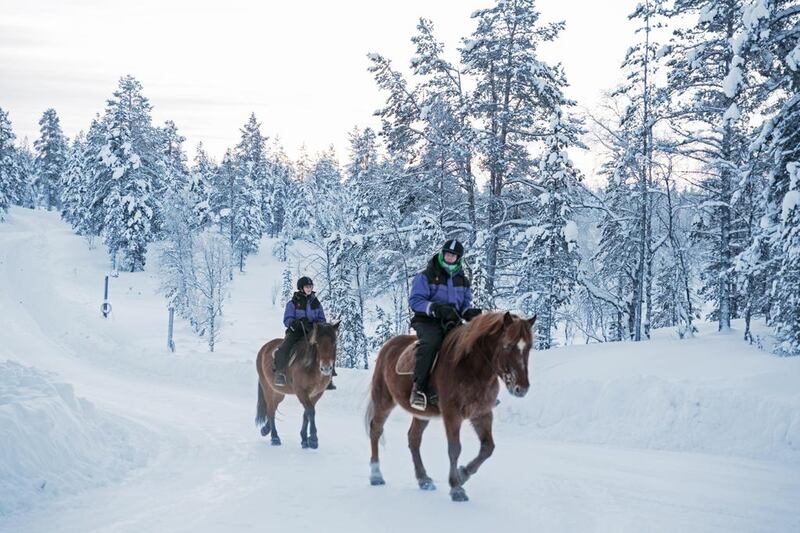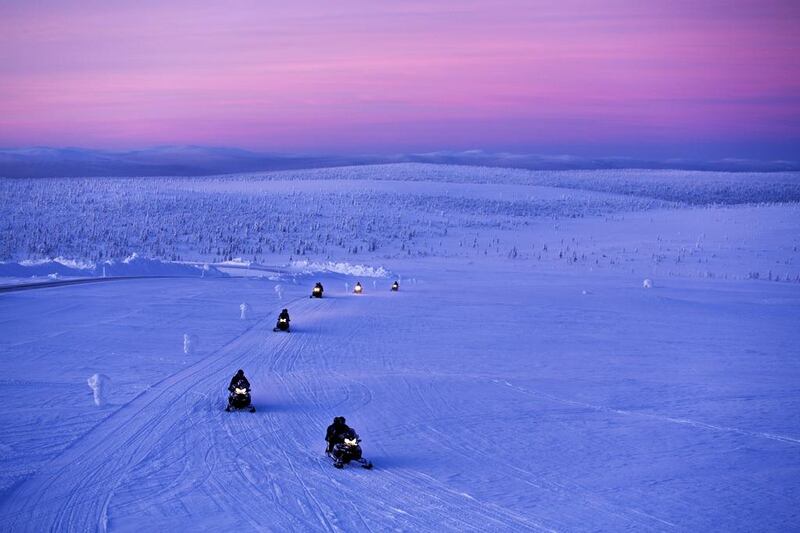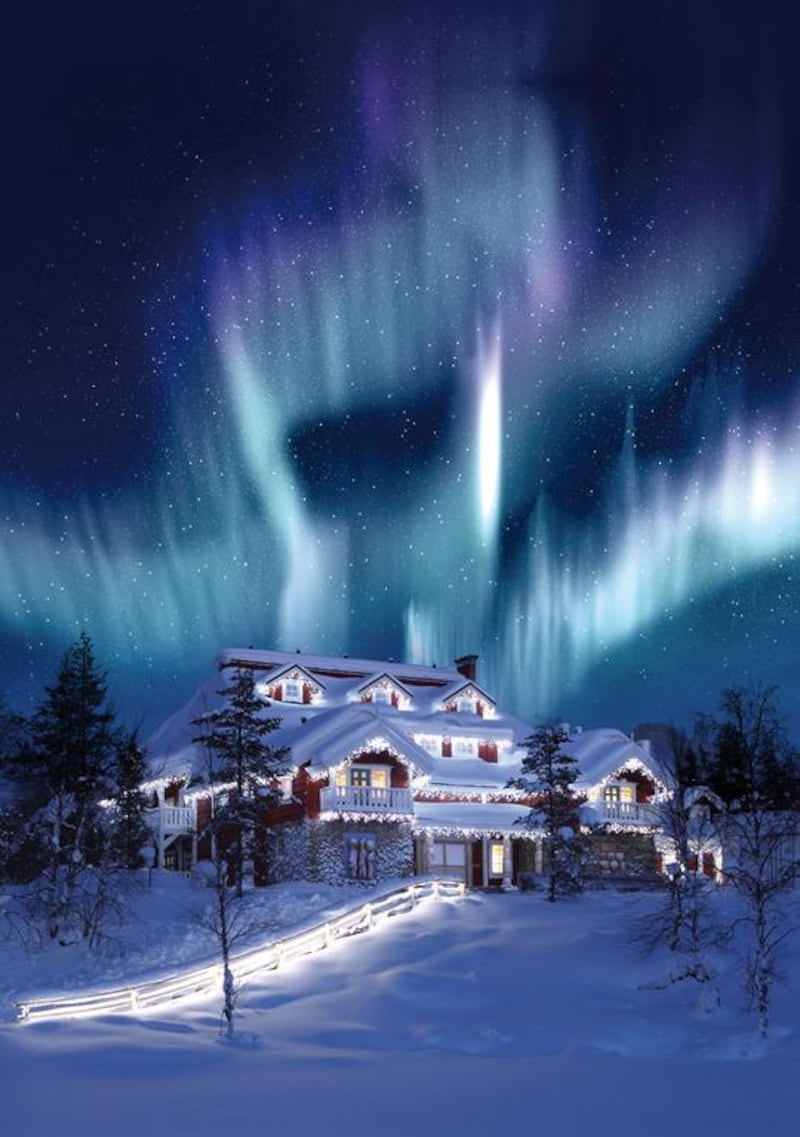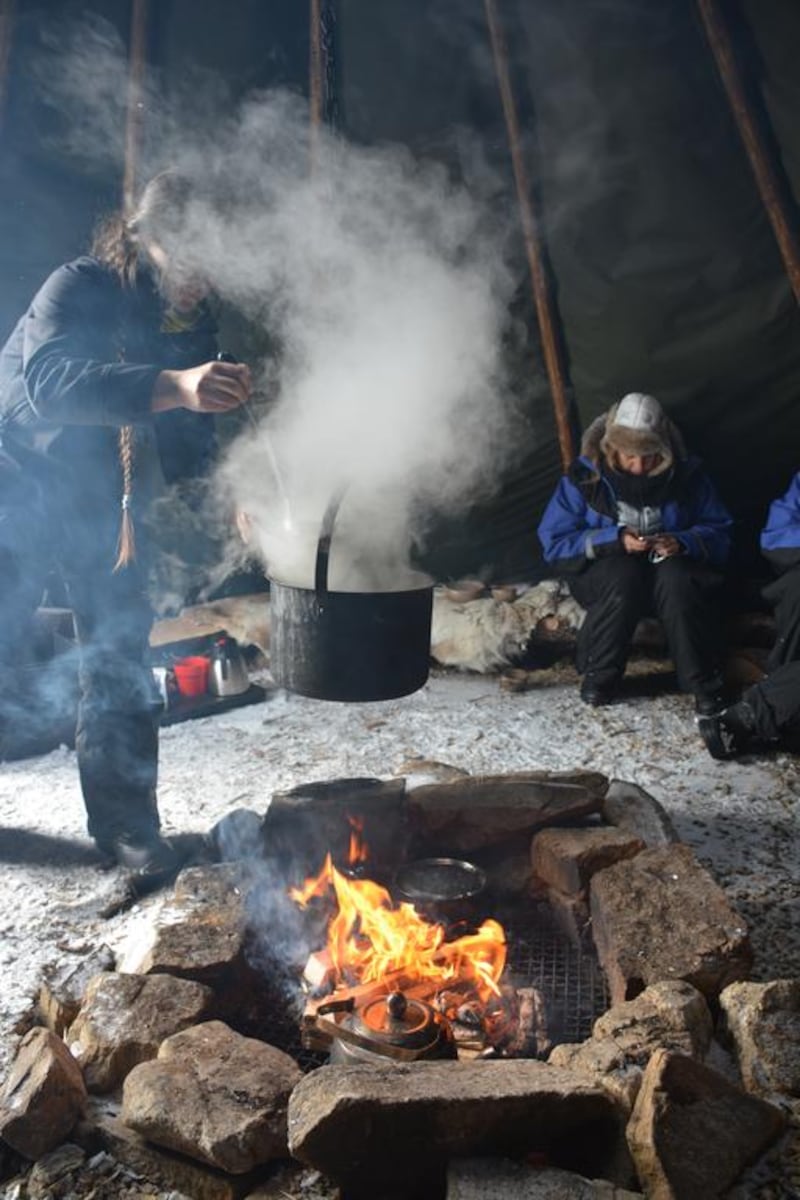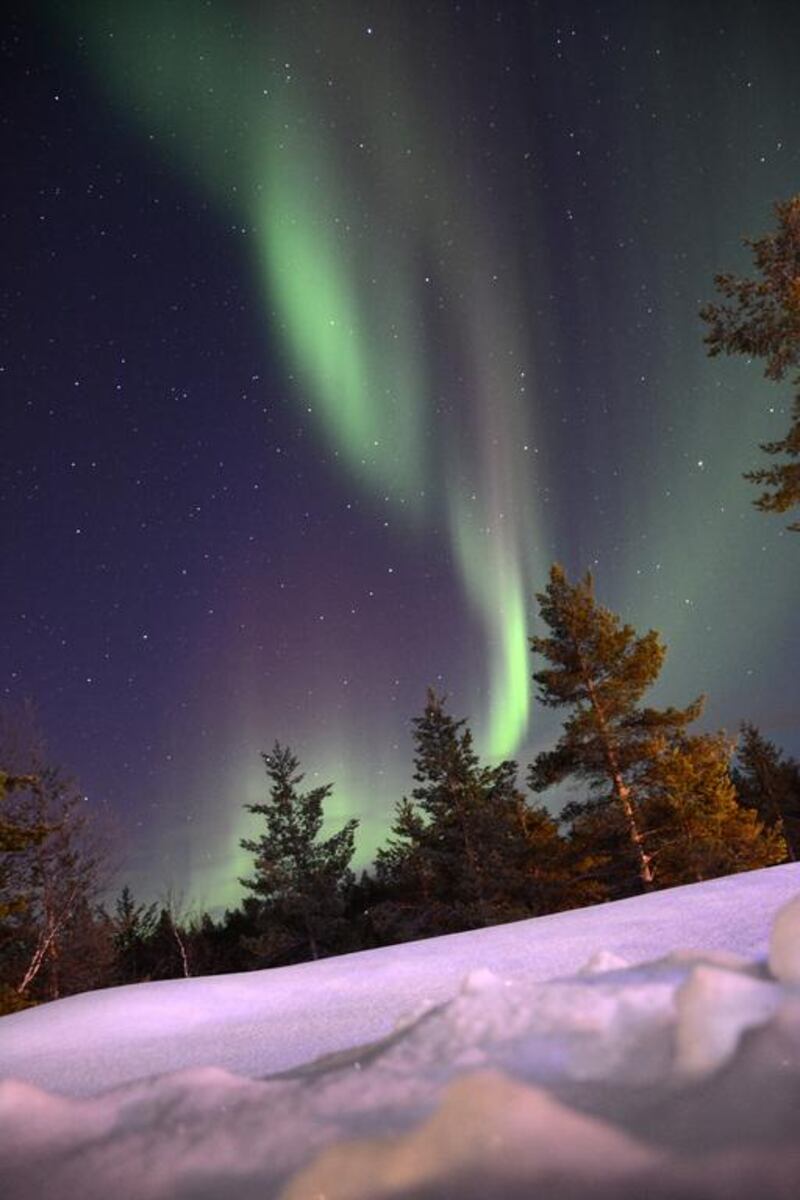“Where are you going?” “I’m going to see the Northern Lights. Inshallah.” Never before has my destination been more of a hope than a place. As soon as my flights are booked, I become an aurora hunter, a daily checker of Northern Lights forecasting websites, comparing Kp indexes and solar wind speeds, coloured charts and three-day outlooks. While the last thing I want is to become an aurora borealis bore, what would be even worse, I decide, would be to travel all the way from Abu Dhabi to Lapland to see the Northern Lights and then ... not see them.
In my favour is the fact that 2015 is the end of a three-year “peak phase” of solar activity, and, in any year, November and March are the best months to see the lights, which are the result of charged particles from the sun colliding with atoms near the magnetic north pole. I am travelling in March, and I’m staying four nights — which allows for a couple of nights of cloudy or snowy weather (the lights are only seen in clear skies during winter, which in northern Finland means from the end of August to the end of April). Remote locations are better because there is less light pollution to interfere with nature’s show.
Worryingly, two weeks before my trip, my hosts report perfect conditions: “Yes, three days in a row this week we have seen beautiful auroras. We had a clear sky during the day, so we had good chances. Maybe tonight we will see them too, as the sky is very clear with beautiful sunshine and minus six degrees.” Then, on March 17, a week before my trip, Northern Lights activity in Europe peaks. A massive solar storm, combined with clear skies, means that spectacular shows are seen as far south as England. This cannot possibly carry on for another week, I think – and I’m right. Snow is on the way.
We land in a snowstorm at 4.30pm. The runway at Ivalo is covered in snow and visibility is so poor that only a few trees and the airport’s main buildings can be seen. But snow is nothing to the Finns, who are in their element in it. Our minibus driver takes off into the half-light at over 100kph on snow-covered roads, not skidding once thanks to tiny studs embedded in the tyres. While main roads are gritted, it’s not practical or possible to clear all of them.
We arrive at Kakslauttanen Arctic Resort – 250 kilometres north of the Arctic Circle and surrounded by wilderness – just in time for dinner. The bearded, lumberjack-shirted owner, Jussi Eiramo, who has just opened a brand new, luxurious section of the resort, with dozens more state-of-the-art glass igloos and the world's largest log restaurant, is beside the fire grilling an enormous fillet of salmon, which he has soaked in salt water and roasted with salt and pepper on open flames. "It's perfect to grill as it's so fatty," he says. Despite the success of his enterprise, which began 38 years ago, there are still some things he likes to do himself. We devour the salmon after a starter of soup and freshly baked and buttered rye bread, as he tells me about how, in the late 1990s, he was the first to come up with the idea of having glass igloos. "I used to see Asian tourists out in minus 40 degrees, waiting for the Northern Lights to arrive," he said. "And then I thought maybe it's possible from your bed."
The fact that it’s impossible to predict the appearance of the lights more than a few days in advance has created an excellent business opportunity. Thousands of tourists book Northern Lights packages every year, spending thousands of euros per person. Those who try to cut costs and only stay for one or two nights are often disappointed. This year in his West Village, deep in the forest, Jussi has also opened a host of large new log cabins and glass igloos, which combine the spacious comfort of a log cabin with a linked, transparent domed viewing area. I have a log cabin and a glass igloo – just in case. In terms of comfort and space, I prefer the log cabin, which is typically picturesque, with a red door and pretty entrance topped with half a metre of pristine snow. There’s even a sledge outside and a brush to clear the porch and steps. Inside there’s a pine floor, central heating – or, if I prefer, a log fire – plenty of hot water, a small kitchenette and a comfy bed, Lappish rugs and its own mini sauna. If I had children they’d be tucked up in their own cute little adjacent room, with bunk beds carved out of logs. I use this as a dressing room and suitcase storage area. There’s no TV or Wi-Fi or phone (and thus no room service), and the mobile signal is patchy.
The following morning it has stopped snowing, though the skies haven’t cleared. Most of my winter trips, until now, have involved skiing, so there is something especially decadent about a winter holiday conjuring up all the delights of a childhood fantasy – it’s a joy to simply step outside and walk around. After breakfast in the cavernous log restaurant, it’s time to try some activities. While most of the world closes up in the snow, in Lapland, there’s even more to do in the winter than summer. This goes a long way towards justifying winter trips here, even if the lights don’t make an appearance. Nothing is fun in extreme cold though, and while daytime temperatures of around zero in March are balmy compared to December through February, when temperatures of between minus 20 and minus 40 are common, all guests have the option of borrowing a blue-and-black thermal suit and a pair of comfortable lined rubber boots, which make sitting on snowmobiles, sledges and horses easy. Suitably suited, I first try horse riding through the woods at nearby Kamisak Farm. I’m on a pretty, stocky Finnish horse called Tara; there’s no galloping across country, but the almost-silent trek through the clear air and softly squeaking snow is relaxing. Even during the winter, some of the horses are hardy enough to be kept outside in fields, their thick, buttery blonde hair almost competing with their bright environment.
From the stables it’s a short walk to the husky kennels over pristine snow. We see marks where a ptarmigan has flapped its wings and taken off and Arctic fox prints. Brown bears can be found around the Russian border, but are rare. There’s time for a coffee and soup break beside an open fire in a small tepee before we’re divided into pairs for husky sledding. While one person sits comfortably covered in a rug, the other steers and brakes. Because the six healthy-looking Siberian huskies who pull us are well-behaved, and the ground is mostly flat, it’s surprisingly easy and fun. We only go for about half an hour, switching from sitting to steering halfway through. For those who want more, the same farm can arrange journeys of up to five days into the wilderness.
After lunch back at the East Village, I take a look at the snow igloos and snow chapel that Jussi builds each winter season. With Sweden's Ice Hotel and similarly gimmicky competition elsewhere, Jussi has also seen a business opportunity in offering overnight stays rugged up on blocks of ice and weddings literally on ice. I'm not tempted, but each year hundreds of mostly Asian tourists are, with some believing a blessing or even conception under the Northern Lights to be auspicious.
Cross-country skiing is next. Of all the activities, it's probably the one that I'm least looking forward to. But while tiring, it also proves quite satisfying. Thinner than normal skis and with mobile clips at the back, you shuffle along tracks carved by previous skiers. We're on the edge of Urho Kekkonen National Park, and there's rather a lot of uphill. I wonder whether it wouldn't be more economical to walk the route we are taking, but the rhythm needed is enough to keep you moving forward, and I soon work up an endorphin-filled sweat. After 90 minutes it's time for dinner — this time a juicy reindeer steak in a cranberry sauce.
After dinner, it’s not time for bed but off to the nearby tourist village of Saariselka, for “aurora hunting by snowmobile”. Sadly, thanks to a sky thick with snow, I know we’re not going to see any auroras tonight. Even worse, the visibility is so poor that the spectacular landscapes we would have seen on our three-hour expedition are completely hidden. But nothing can take away from the sheer thrill of a snowmobile. Ours are bright red Lynx Adventure models and about three metres long. The front of the machine is on skis, propelled by a rotating track at the back. It’s surprisingly smooth, powerful and agile. After being given helmets and shown how to steer and operate the kill switch, we’re off at up to 50kph, an exhilarating speed but far short of the machines’ 150 kph capability. We cover about 70km of woodland path and open fell, stopping every now and then to shine lights into the forest, drink hot coffee and allow others to catch up. Despite the amount of traffic, the noise and the fuel consumption — it takes seven litres of fuel to go 100km, so about the same as the average car — the environment seems pristine.
I speed along the outside of the track over some tempting-looking clean snow, only to feel the machine slowly sinking to one side — I manage to power out of it but some people tip over. In bed that night I can still hear the hypnotic chug of the engines and see the exhaust rising like white smoke into the air.
Barely 12 hours pass before the next excursion, this time to Lake Inari. Measuring in at more than 1,000 square km, Inari is the largest lake in Lapland and remains frozen from November until June. Snowmobiling over the lake is spectacular thanks to the scenery, though frustratingly, we have to go at 15kph as a French woman in the group riding with the leader in a sleigh is pregnant, and we’re not allowed to overtake. After about half an hour our guides demonstrate ice fishing, before we have a go ourselves. We drill down through the ice to make a hole and dangle our small plastic fishing rods into the water. Despite apparently being well stocked with Arctic char, white fish, grayling, perch and pike, none of us are successful.
Instead we toast sandwiches over a campfire close to the lake’s edge, followed by a look inside Pielpajärvi Wilderness Church, a wooden church built in 1760 and one of the oldest buildings in the area.
Back at Kakslauttanen, the hours of standing on the lake have taken their toll, so it’s time to heat up in the resort’s gloriously rustic sauna complex. Just as the country deals well with the cold, it knows how to warm up, with about 3 million saunas for a population of 5 million people — about one for every household. The resort’s traditional wood-fired smoke sauna, which can be hired (along with a cosy relaxation room and bathroom) exclusively by groups, is one of the world’s biggest. After about an hour of baking ourselves until we cannot bear the heat any longer, our group dons thick socks and rushes outside to immerse our smoke-blackened bodies in a section of icy lake. It’s invigorating, and the ticket to a good night’s sleep.
No Lapland winter experience could be complete without reindeer and a visit to Santa. In a remote farming area north of Urho Kekkonen National Park, we visit a Sami reindeer farm run by a man called Pintie, who claims: “my reindeer understand me better than anyone else.” In a region in which there are more reindeer than people, they are still the mainstay of the indigenous Sami people, who seem to love them and eat them in equal measure.
Though some tourists have an aversion to eating reindeer thanks to their Bambi-like appearance, their meat is lean, tasty and versatile, making its way into soups, stews, pies, pizzas or steaks.
On this occasion our less-than-bloodthirsty group has arrived for a gentle sleigh ride through the trees. Two people sit in each sleigh, comfortably covered in a warm blanket, while a single sturdy beast tows us along. They are surprisingly energetic and agile, trying to overtake each other, though ropes prevent this. The scenery is beautiful – storybook wooden farmhouses and deep, rolling snowfields with a glittering, frosty surface. Back at the farm, Pintie, who wears traditional dress, has us all making our own pancakes over an open fire, and serves coffee. Then he sings a song and bangs a drum: according to our translator, his song chiefly involves a man’s worry about lost reindeer – that they could be hungry or in danger.
Back at Kakslauttanen, we have an appointment with Santa, whose “home” is at the resort. Feeling even more like a child than usual, I walk past a crooked, fairy-tale-style tower (“the ‘elves’ home”), over a little bridge and climb the stairs up to his house. It’s dark outside, but inside is a blaze of warmth, with a huge, beautifully decorated tree. Santa opens the front door and welcomes us inside, giving us each a gift and taking requests. He’s looking a bit thin, I remark. “I’ve been doing Zumba,” he replies.
Two nights down, our group is more concerned about the Northern Lights situation. However, having intermittently switched between bright sunshine and thick cloud, by 9pm the sky has cleared again and, a few hours later, to our excitement, a white band appears in the sky. At first it looks like the Milky Way, but it soon stretches and expands, then turns a pale green. A faint arc hangs above the resort like a rainbow. I head outside into the minus 20 degree air, and am immediately struck by the magnificent presence of the sky, pure and freed from pollution. I’ve worried slightly that watching the Northern Lights would be a touristy, impersonal experience, but here the real luxury is to be in such a remote place with so few other people, admiring outer space with the naked eye. I’m clutching my new camera, a Nikon D7100; as the professional photographers snap into action, I immediately wish I’d brought a tripod and mastered my manual settings: this is not a situation that the iPhone camera or auto settings can handle. I’m not the only one fumbling with my equipment. “Everyone bought a new camera for this trip, but no one knows how to use it!” cackles a guest from Japan.
A radical thought strikes me. How about for once I don’t take any pictures, and just enjoy the experience? Camera over shoulder, I head to my glass igloo and shut the door on the world. It’s surprisingly spacious, although the bathroom is tiny and only contains a toilet and sink. The futuristic structures are heated through glass panels to avoid condensation — mine is a bit warmer than I would have liked, but centrally controlled. I lie back on the faux leopard skin blanket and angle the electronically adjustable bed to face the stars. The dark and the quiet is mind-blowing and I fall asleep under an arc of slowly morphing milky green, shooting stars and satellites.
There’s one adrenalin-fuelled activity left. The following morning we get back on the road north to Ivalo, from where we take a mysteriously snaking route on B-roads until we reach the gates of White Hell, a testing centre for Nokian tyres. The 700-hectare forested site is difficult to get into, unless you know the right people: our host does. While other operators offer more touristy ice driving experiences, here we’re in the company of engineers and mechanics whose job it is to test and develop car tyres to drive on snow and ice – in real conditions. From November to May, this is like a giant snowy theme park. After a quick tour of the indoor facilities, we’re driven in a staggered convoy of Audis — A5s, Q7s and Quattros – up and down hills, around bends and around a frozen lake, converted into a giant racetrack, which we reach after a quick tour of the facilities. My driver is Yoni, and he’s unconcerned by horizontal driving. I strap myself into the passenger seat of an Audi Quattro testing Northproof tires. He takes me on a demonstration ride around the racetrack, revving, skidding and drifting at will. Then it’s my turn. The fact that we are driving on a frozen lake is the least of my worries, though I’m soon impressed by how well the tyres grip under normal driving manoeuvres. Yoni tells me how to drift – that is to jackknife the back of the car into a swaying, skidding motion by a combination of revving and aggressive steering. Although there are thick banks of snow skirting the edge of the track, I’m not sure driving in rubber boots is safe, so I quit while I’m ahead.
It’s about 9pm on our last night, and we’re at the dinner table about to be served our starters – a prawn salad – when suddenly we hear a loud Australian voice shrieking at the other side of the dining hall. “The lights have started!” En masse, the room empties. We don’t even stop to put on our thermal suits – some leave their cameras on the table. Out in the cool night the sense of excitement is palpable. A huge arc of green hangs above the resort like a rainbow. There are shouts of delight as more lights appear elsewhere. The central band morphs, becoming greener; in other areas, lights disappear then seem to reappear elsewhere.
I run back inside, put on my thermal suit and grab my camera. For the next three hours I take photographs, determined to capture what is without doubt one of the most genuinely magical sights in travel. The fact that each display is different to anything that has come before or will come in the future is key to their enduring appeal. Green flames seem to shoot up over the trees in front of me, then there are spirals, as if will-o’-the-wisp has drawn imperceptibly. Using a very slow shutter speed, I manage a handful of decent, non-blurry pictures. It’s only because the kitchen staff all want to go to bed that we head indoors for what has become a midnight supper.
Essentials
The flights
Turkish Airlines flies from Abu Dhabi and Dubai to Helsinki via Istanbul from €600 (Dh2,390) return, including taxes. Finnair flies from Helsinki to Ivalo from €140 (Dh558) return, including taxes.
The stay
Cabins at Kakslauttanen Arctic Resort (kakslauttanen.fi) in winter cost from €241 (Dh994) per adult per night, based on single occupancy, including breakfast. Small glass igloos cost from €346 per adult per night, based on single occupancy. A three-course set dinner costs from €34 per adult. Airport transfers from Ivalo cost €26 per adult, each way. Activities have to be booked separately through the resort, which can provide a list by email.
